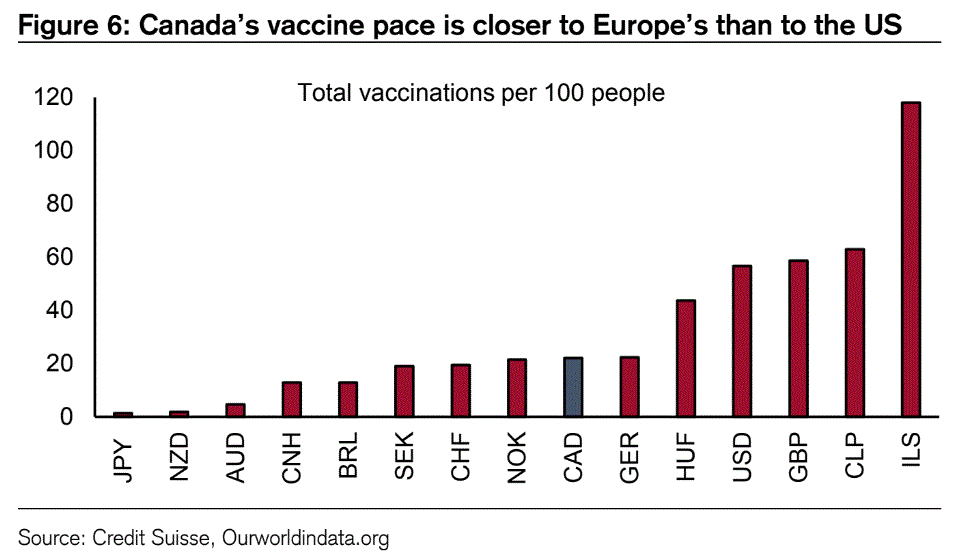Credit Suisse with the note:
April thus far has seen global equity markets in the main continue their steady march higher, led as usual by the pied piper of US equity markets. The laggards / losers have been the likes of Chinese, Indian, Russian and Turkish equities, which reflect local problems linked to covid spikes, monetary policy mishaps, foreign policy risk or credit concerns. But the underlying global driver–a post-pandemic global economic recovery–remains alive and well and the primary driver of general asset prices.
Helping risky assets further has been the fact that the benchmark US 10-year yield saw its 2021 peak around 1.74% on 31 Mar, and has steadily moved lower since to 1.62%. This comes despite the release of a strong US Marpayrolls number on 2 Apr, as well as an above-expectations CPI print on 13Apr, against a backdrop of new fiscal spending plans, for this year and beyond, planned by the Biden administration. In essence, it seems the market for now has priced in enough in terms of these various upside risks for US yields, and is prepared to sit tight for a period and see whether strong data are sustainable over a multi-month period and / or whether Biden’s new spending plans actually materialize anywhere close to initial headline suggestions. After all, Fed officials are still pushing back against narratives that imply that mere strong forecasts should be enough to push them into rate hikes, and sticking to the line that actual data for employment and inflation must be convincingly strong before there is any grounds to tighten monetary policy. And Republican politicians have been forceful in rejecting Biden’s latest proposals, following on from their universal objection to the $1.9 trillion stimulus package passed inQ1.
With the pause button having been hit on upside for the US rates, the USD has also struggled this month. This has partly been a result of a positioning washout; markets had approached key US data looking for an asymmetric bias to strong outcomes and the greenback then fell victim to “buy the rumor, sell the fact” price action. But it also partly reflects a modest shift in the narrative towards consideration of the possibility of vaccination / herd immunity laggards like the euro area, or regions with a recent large spate of cases that may now settle down such as Sweden or Eastern Europe, being oversold and deserving correction. As is typical, periods of reduced volatility also tend to benefit thelikes of CAD and MXN, which offer still-decent nominal rates as well as strong exposure to positive US growth.
Putting these developments together, we are not minded to change any of our key view for Q2 as highlighted last week in our FX Outlook. We see the price action so far in April as corrective in the case of currencies like USD and GBP that have lost ground and idiosyncratic in the case of typically pro-risk currencies that have lagged (e.g.RUB or INR). We still expect to see down the line the USD resume its rally against the key funding currencies (EUR, CHFand JPY), and we are looking to fade rallies in EURUSD towards 1.20 as one example. This week we also recommend selling EURGBP around 0.8790, which detail below.
The bottom line is that our expectation is for the market to overcome its sense of indigestion from the sharpness of US rates moves so far this year and to again look for another leg higher in US yields as Q2 proceeds, and we expect this to benefit the greenback. We do not yet fully subscribe to the idea that“peak covid divergence” has already been seen between economies on track to open quickly as herd immunity approaches such as the US and UK, and those like the euro area and Japan which are either seeing worsening conditions onthe ground and /or are lagging materially in terms of vaccinations. We still prefer to play pro-reflation views outside the USD in linked currencies like MXN or CAD and / or other covid outperformers such as GBP, funded out of EUR, CHF or JPY.
As far as this week goes, we see US Mar retail sales data as an important test of our thesis. If the numbers are strong and US yields / the USD still fail to react positively, or if they are weak and these variables move down relatively sharply, we would need to consider more seriously the possibility that we are wrong about the positioning washout being nearly complete, and we would likely need to adjust our views and entry levels accordingly.


